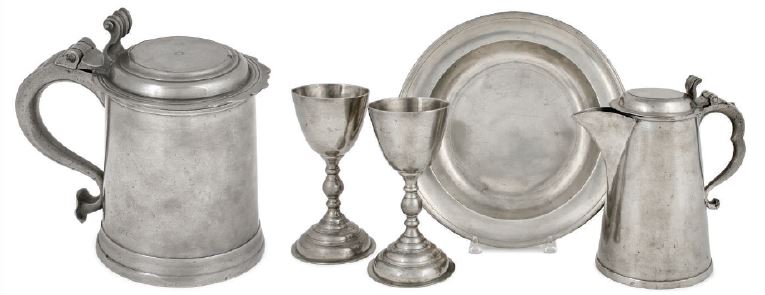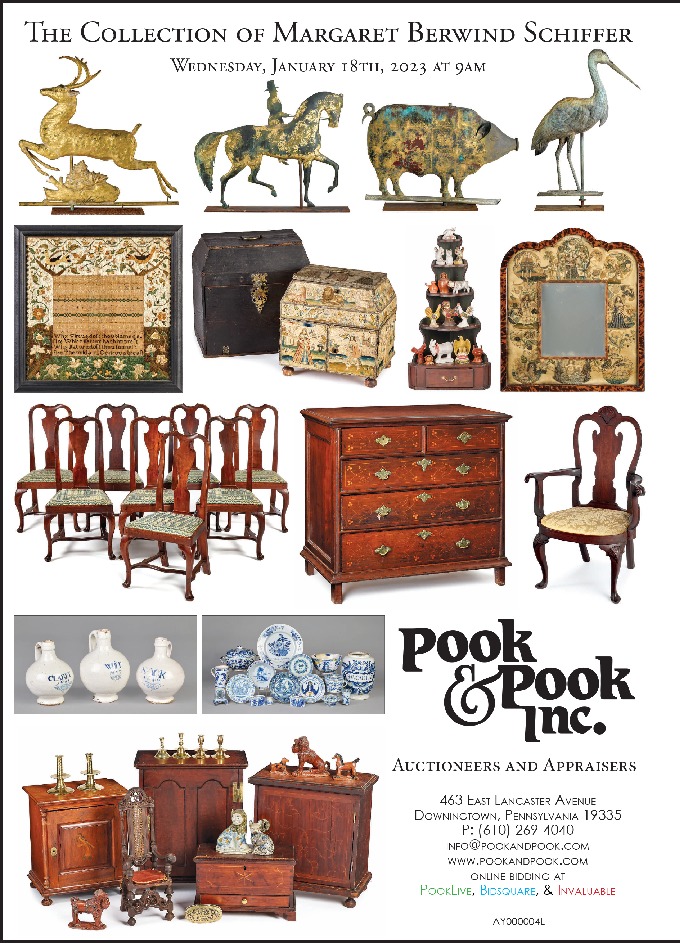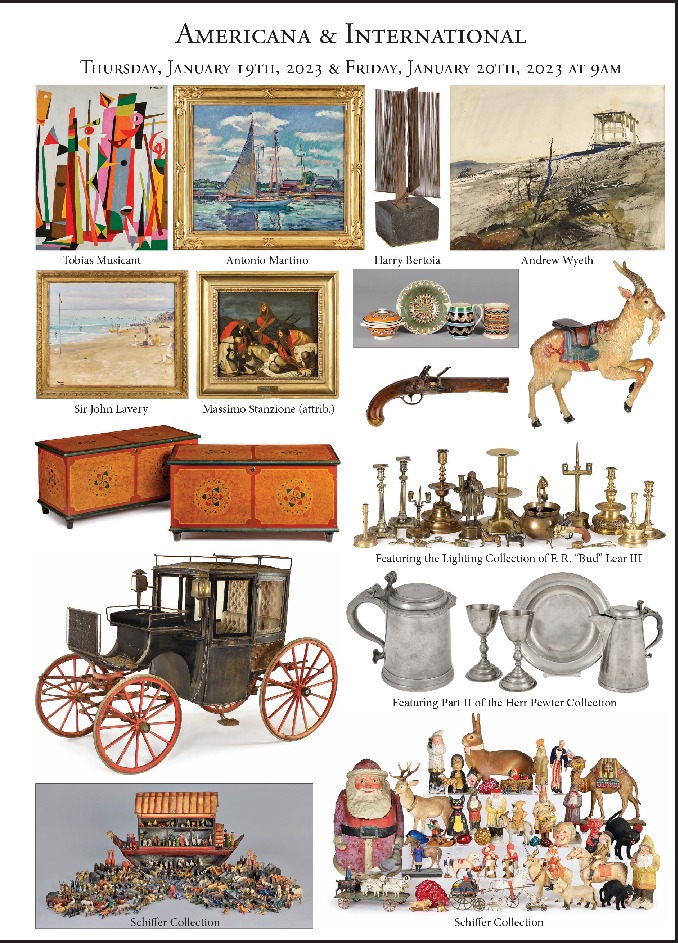Events
Home / Events

Pook & Pook: Americana & International
Thu Jan 19, 2023 - Fri Jan 20, 2023
463 East Lancaster Avenue - Downingtown, Pennsylvania 19335
Pook & Pook: Americana & International
January 19 & 20 at 9am
463 East Lancaster Avenue Downingtown, PA 19335
www.PookandPook.com
info@PookandPook.com
610-269-4040
DOWNINGTOWN, PENN. — Over the course of three days, January 18, 19 and 20, Pook & Pook will auction three major collections of American and International antiques and art, along with items from other prominent estates, museums and collectors.
Margaret Berwind Schiffer was a scholar/collector and author, whose many interests included the Delftware, furniture and needlework of the Quaker, British and European settlers of Chester County, Penn. The Schiffer collection’s 82 lots of Delftware chargers, plates, apothecary jars and bottles features examples like an English Delftware blue dash Queen Anne charger, circa 1705, an English King George blue dash charger, circa 1715, and a rare Delftware rabbit hunting platter, dated 1730 or 1736, is initialed ES. Also of note are three lots of English wine bottles, labeled and dated: Claret 1648, Whit 1643 and Sack 1649.
Furniture includes a George I mahogany chest of drawers, probably Welsh, dated 1696, initialed IPS, the top and front profusely inlaid with scrolls and tulips. A miniature Jacobean carved walnut armchair, early Eighteenth Century is illustrated in Schiffer Miniature Antique Furniture and described as perhaps “the finest surviving Stuart miniature in existence.”
Among the collection of Charles II needleworks are a rare silk embroidered casket, circa 1670, decorated with various allegorical scenes with figures and animals, retaining its original ebonized pine case, and a Charles II stumpwork mirror, circa 1670, in a mahogany and tortoiseshell veneer frame enclosing an embroidered border topped by a lute player seated in an orchard arbor, enchanting humans, a lion, a deer and a mermaid.
The Bud Lear collection is a lifetime assemblage of 55 lots of copper-alloy candlesticks manufactured between 200 and 1700 CE. Illustrating the history of development and relationships between forms across Europe, the Lear Collection is composed of notable and one-of-a-kind examples. A rare brass candlestick in the form of a standing Martin Luther, probably Nuremberg, first half of the Seventeenth Century, is the only known example of its kind.
With designs derived from the coeval lion aquamaniles, two lion-form candlesticks, Thirteenth/Fourteenth Century, are attributed to northwest Europe, however, one was found in England and bears a distinct resemblance to period English depictions of lions and leopards.
Early English varieties include one of only two known Fifteenth Century English detachable double-socket arm candlesticks, and a small candlestick, Fifteenth Century, having two castellated sockets on Gothic pierced arms. A large English early Tudor Chalice and Paten candlestick is an example of both design and execution in the mid-Sixteenth Century.
English Trumpet candlesticks include a rare late Sixteenth/early Seventeenth Century form, which is one of only two surviving examples known, and a unique and large Seventeenth Century English candlestick, which has a highly unusual removable bobeche, most likely used as a hand-held pan light.
A pair of massive Seventeenth Century sheet brass candlesticks, probably Dutch, with overall repousse decoration, are similar to a pair found in the Victoria & Albert Museum. A brass double socket pricket candlestick, Germany, late Fifteenth Century is an unusual variation of the Three Kings form, with D’Allenagne collection provenance. Of unusual and totally original form, a brass candlestick, northwest Europe, Fifteenth Century, has a Heemskerk upper shaft supported by a Three Kings base. A Safavid brass double-armed candlestick, Sixteenth Century, is a complex single casting.
Another highlight is a rare Flemish twin-spouted lavabo, Fifteenth Century, with cast female heads and animal-form spouts.
Notable lots from other collections include a cast brass “Tudor” or “Chalice and Paten” candlestick, mid-Sixteenth Century, which is similar to one sold in the William du Pont collection, Sotheby’s, 2022.
A dramatic oil on slate attributed to Massimo Stanzione (1585-1656) is titled “The Deposition from the Cross.” A similar painting is in the collection of the National Gallery, London. Provenance includes the Chesrow-Cesario collection and prior to 1874, the Bartaja collection of Naples, Italy. A Flemish School, late Sixteenth Century, oil on oak panel Madonna and Child, is a scene of the two, each holding a piece of fruit, seated in a landscape.
From Normandy Farms, the Strassburger estate, comes one of the highlights of the sale, Sir John Lavery’s (British 1856-1941) oil on board titled “The Beach Deauville – Morning,” signed lower left, titled verso and dated 1926. Also from the same collection are a massive George III mahogany breakfront and several lots of silver by Paul Storr, including covered entree dishes, toast rack and armorial plates, 1809-10.
Thursday, January 19, will feature part two of one of the most prestigious private collections of American pewter in history, the collection of Drs Donald and Patricia Herr, as well as the collection of the Packwood House Museum of Lewisburg, Penn.
The Herr collection is headlined by a trove of rare Philadelphia finds: a pewter flagon, attributed to Johann Philip Alberti, is engraved Georg Kirchen, 1763. Also attributed to Alberti is a circa 1770 pear-shaped footed teapot. Pieces by famed Philadelphia pewterer and patriot William Will include a teapot, circa 1780, a quart mug, covered sugar and a creamer, all bearing his touch mark. A rare teapot, late Eighteenth Century, is possibly the only example known bearing the Love touch mark. A flagon attributed to Love, circa 1800, has St Michael’s Lutheran church, Philadelphia provenance.
Other Pennsylvania pewter includes a Lancaster ciborium, circa 1765, bearing the touch of Johann Heyne, and a rare Peter Derr (Berks County, 1793-1858) bronze spoon mold and pewter spoon, impressed P Derr 1820.
An Albany, N.Y., pewter communion service, circa 1810, bears the touch of Timothy Brigden and includes a pair of chalices, flagon and a deep dish marked by Spencer Stafford, provenanced deaccessioned property from the Henry Ford Museum, which records the set purchased by Levi Morton Dewey, circa 1840, from the church in Pomfret, N.Y. Other New York pewter includes quart mug, circa 1780, bearing the touch of Frederick Bassett, a pewter chalice attributed to Henry Will, circa 1775, and an Albany or New York pewter tankard, circa 1785, bearing the touch of Peter Young. A tankard, circa 1760, bears the touch of William Bradford Jr.
Pennsylvania painted furniture on Thursday includes a rare pine hanging cupboard, dated 1843, the front decorated with a schoolyard scene with flagpole, children at play and bonneted teachers beneath a moon and starlit sky, all above a wooded scene with figures, dogs and flying geese, provenance to David Schorsch. A rare Samuel L. Plank (1821-1900) painted pine and poplar hanging wall box retains its original decoupage decoration with an old alligatored finish. Two orange-gold York County painted poplar dower chests, Nineteenth Century, retain their original vibrant decoration. Lancaster painted pine dower chests include one attributed to John Flory (1754-1842) dated 1798, inscribed Sarah Richter, and another signed by the maker Johannes Rank. Decorated with rampant unicorns and birds, a Berks County, late Eighteenth Century example is another dower chest.
The only word to describe a Pennsylvania painted pine architectural shrank, circa 1770, is monumental; the stepped cornice overhangs a central section with two elaborately decorated doors with painted birds and vases with flowers, above a two-drawer base, all resting on ball feet.
Another highlight is a Philadelphia Chippendale mahogany tea table, circa 1770, the pie crust top tilting on a birdcage support, with suppressed ball standard and carved cabriole legs terminating in ball and claw feet. A Pennsylvania Chippendale tiger maple tall chest, circa 1775, with highly figured graining, retains its original hardware.
A Dentzel Co., Philadelphia carved and painted carousel goat, circa 1900, is attributed to the carver Daniel Mueller.
Artwork includes, an oil on canvas rendition of Gilbert Stuart’s 1806 “Washington at Dorchester Heights,” attributed to Jane Stuart (American, 1812-1888). The youngest daughter of Stuart, Jane became well-known in her own right and executed numerous copies of her father’s works, most of George Washington. A copy of the same painting by Jane is in the collection of Mount Vernon. A mid-Nineteenth Century copy of Gilbert Stuart’s 1806 “Athenaeum Porthole” portrait of George Washington is sold together with its original gilt frame.
The Packwood House Museum, Lewisburg, Penn., was the creation of Edith and John Fetherston. The museum’s collection ranged from Southeast Asia to central Pennsylvania. Items of special local interest include a 1790 vellum deed for lots of land in Louisborough (Lewisburg); a 1789-1826 journal of gunsmith Samuel Baum, of New Berlin, Union County; an H. Kockler Lewisburg percussion combination gun; and a Union County redware jar and cover, Nineteenth Century, attributed to James Nieman and/or Adam Maize. Stoneware from central Pennsylvania includes 12 Nineteenth Century works by Cowden & Wilcox, Harrisburg, including a crock with cobalt man in the moon decoration and a 4-gallon jug with cobalt bird on grape cluster decoration. The Packwood Museum was famed for its large collection of Pennsylvania quilts, 51 of which are featured in the sale. A highlight in the firearms category is a US Model 1811 North transition flintlock pistol. From the museum’s library are collecting references, including Hobson, Yetts and Binyon, The Eumorfopoulos Collection and Hobson, A Catalogue of Chinese Pottery and Porcelain in the Collection of Sir Percival David, 1934.
Pennsylvania artwork sold on Friday include a Harry Bertoia Sonambient steel and brass wire sculpture.
Another highlight is an Andrew Wyeth (American, 1917-2009) watercolor titled “The Lookout or Borestone Mountain,” signed lower right.
Fine art from the estate of Robert J. Bergelson includes a John Fulton Folinsbee (American, 1892-1972) oil on panel landscape titled “Bourre Hillside,” 1926; and a Pablo Picasso (French, 1881-1973) large glazed and incised earthenware charger “Dove at the Dormer,” 1949.
The wide variety on Friday includes a Philadelphia Federal mahogany sideboard, circa 1800, retaining its original brass hardware with embossed busts of Thomas Jefferson, and an English burl walnut bracket clock, mid-Eighteenth Century, with works signed by George Clarke, London.
An American sheet iron weathervane, early Twentieth Century, features a sow and her two piglets with a heart-shaped directional. Featured in Nissenson and Jonas, The Ubiquitous Pig, with a quote from Harry Truman, “No man should be allowed to be president who does not understand hogs.”
Mocha from the estate of Robert J. Bergelson includes a mocha bowl, Nineteenth Century, with dendritic tree/seaweed decoration, together with hardbound book – Rickard, Mocha and Related Dipped Wares, 1770-1939, and illustrated on its cover.
Finally, a lucky bidder can drive home in a Brougham undercut carriage, manufactured by Brewster & Co. of Long Island, N.Y., circa 1890. Provenance: originally made for Frederick Bourne, president of the Singer Sewing Machine Company; Normandy Farms, Penn., Strassburger estate.
For additional information, www.pookandpook.com or 610-269-4040.

Antiques and The Arts Weekly is the nation’s leading weekly publication on the antiques and the arts trade, and is available both in print and online.
Each issue average between 100-200 pages and includes reporting on auctions, antiques shows and the arts while providing a platform for both buying and selling.
We have been providing breaking news and important information on the world of antiques and the arts since Publisher R. Scudder Smith started Antiques and The Arts Weekly back in 1963.
Contact
LOCATED AT:
5 Church Hill Road / Newtown, CT 06470
HOURS:
Mon - Fri / 8:00 am - 5:01 pm
PHONE:
(203) 426-8036


